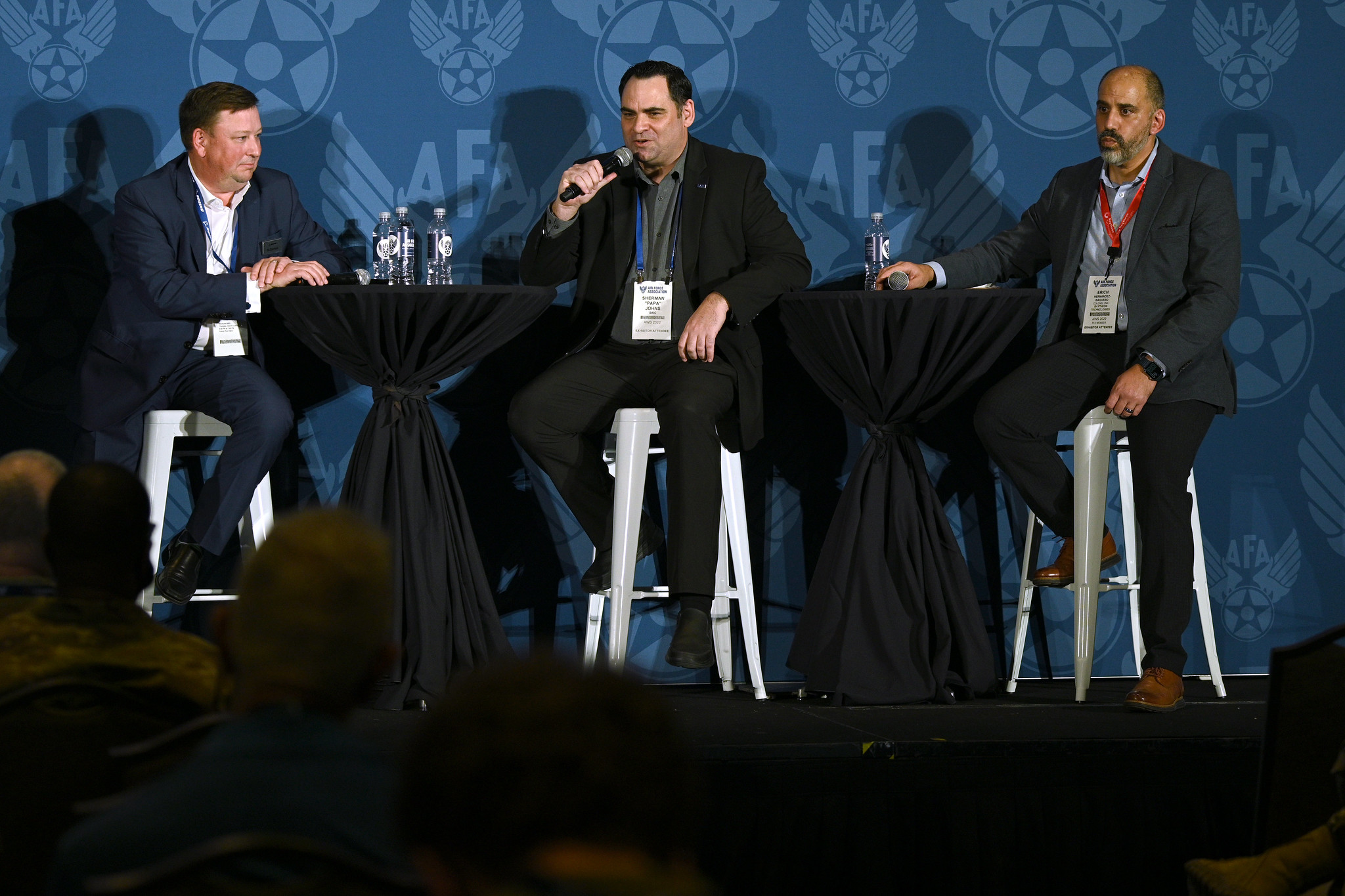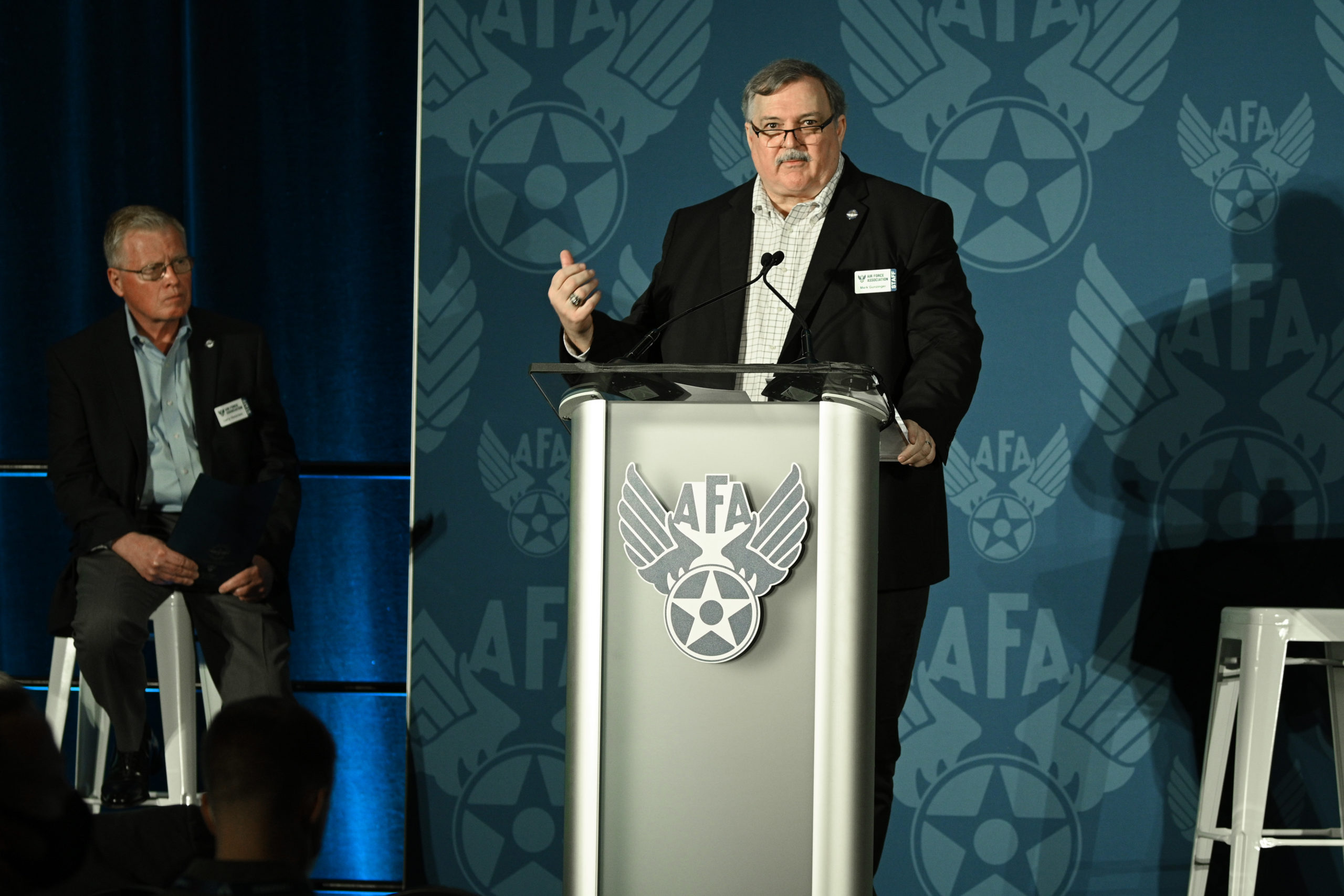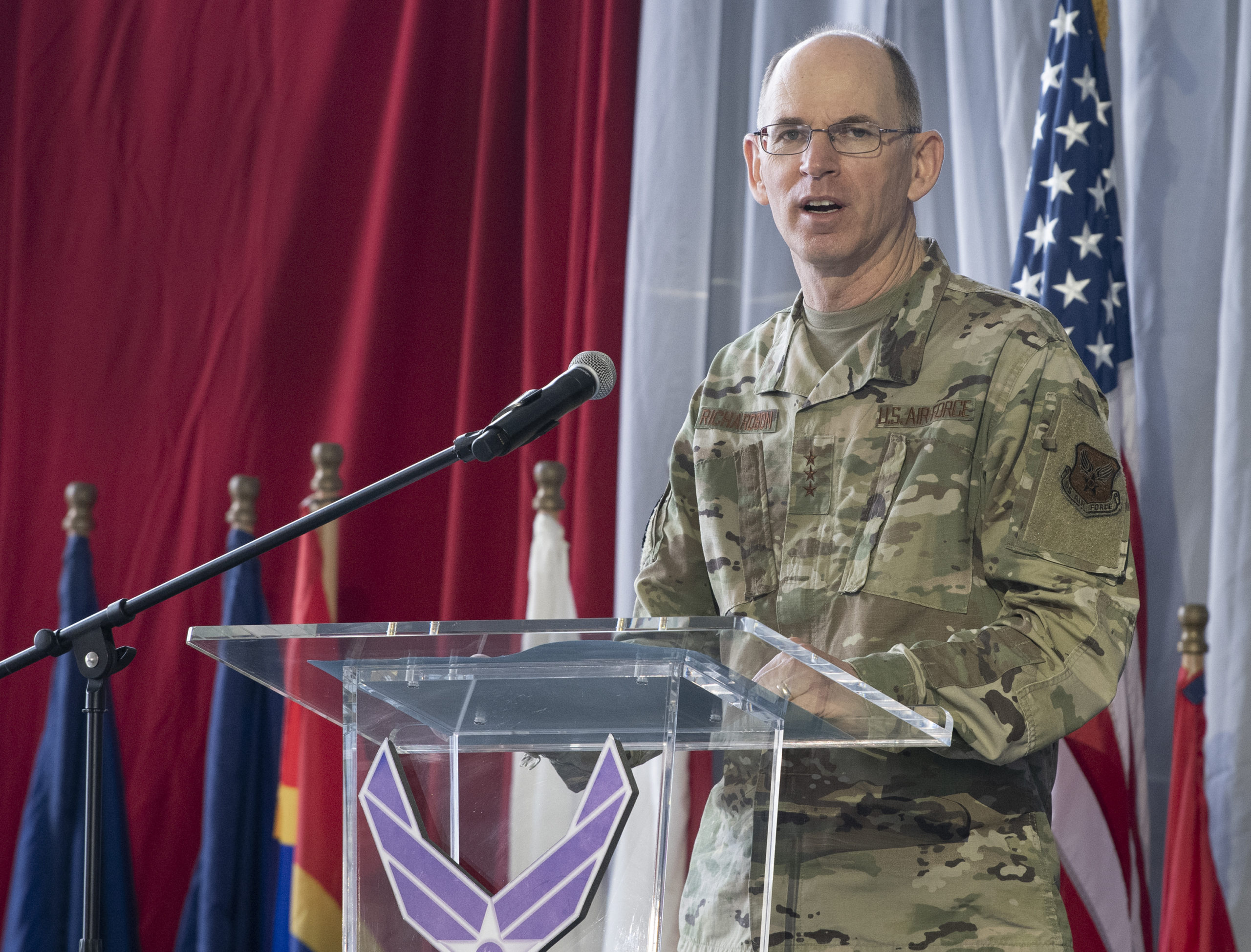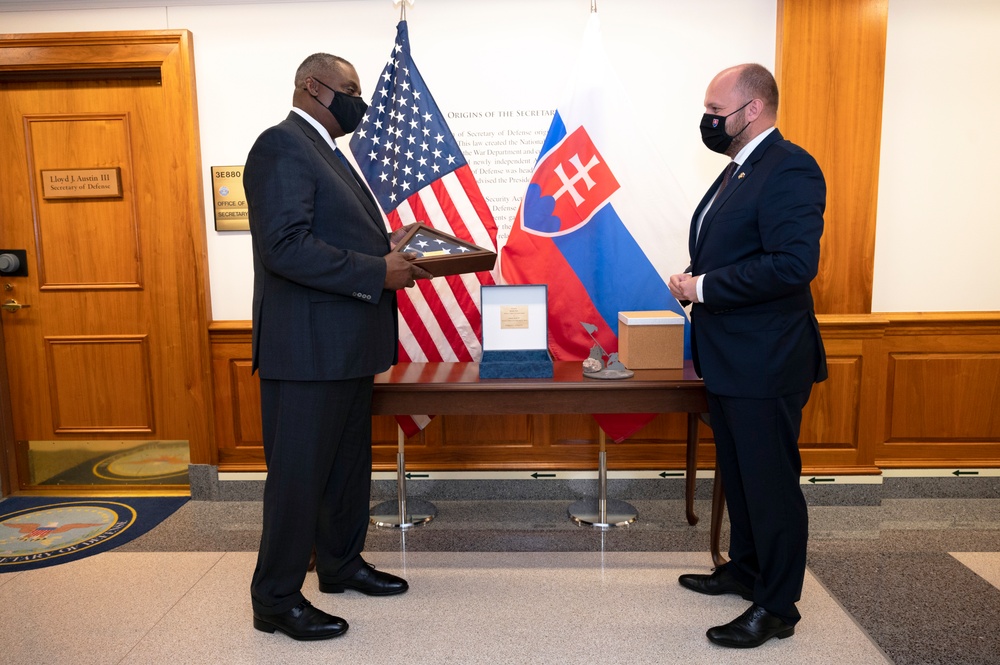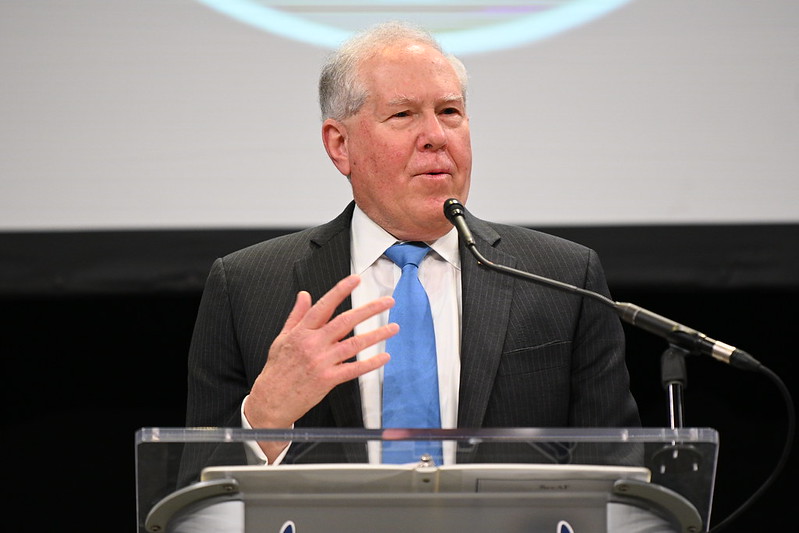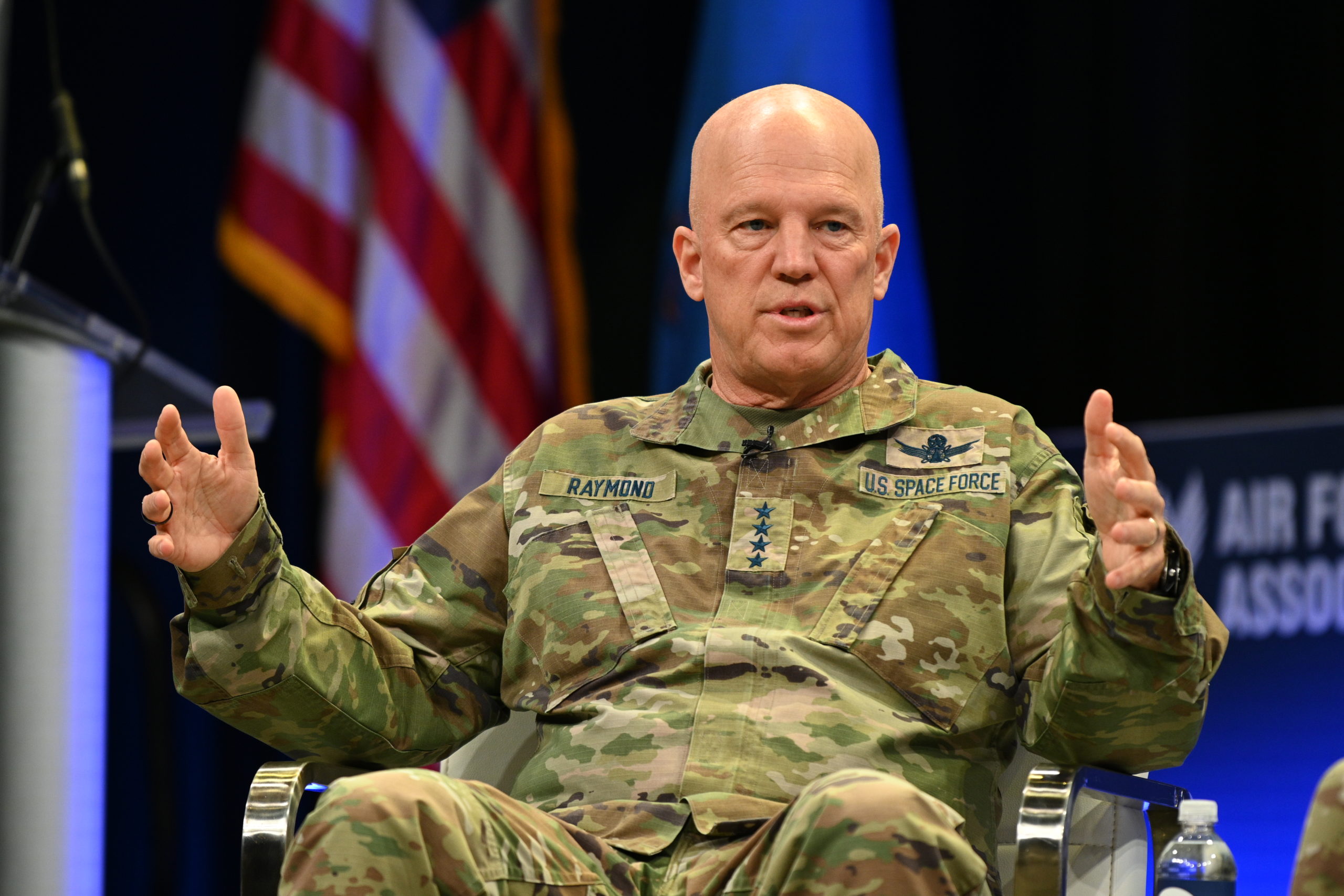Lt. Gen. Michael A. Guetlein hosts Bryan “Stu” Eberhardt, senior director, global sales and marketing, Boeing Satellites; Erich Hernandez-Baquero, executive director of Raytheon Intelligence and Space; and Sherman Johns, director of space strategy and growth, SAIC, to discuss “Space Superiority” at the AFA Warfare Symposium on March 3, 2022. Watch the video or read the transcript below. This transcript is made possible through the sponsorship of JobsOhio.
Lt. Gen. Michael A. Guetlein: Good afternoon, everybody. Thank you for joining us for this afternoon’s mission capability area session on space superiority, a subject that until recently we really couldn’t talk much about. Before I turn the floor over to our esteemed panelists, let me briefly introduce them. First, Mr. Stu Eberhardt is the Senior Director for Global Sales and Marketing, Satellites, Space and Launch Defense and for Space and Security at the Boeing Corporation. He’s a retired Air Force officer and was previously a Program Manager for Boeing Phantom Works. He now oversees development programs supporting both commercial and US national security customers. Dr. Erich “HB” Hernandez-Baquero is the executive director at Raytheon Intelligence and Space and is a retired Air Force Colonel. Before joining Raytheon he was a senior material leader for the National Reconnaissance Office ground enterprise, and holds a PhD in imaging sciences from the Rochester Institute of Technology. Last but not least, Mr. Sherman “Papa” Johns, is the director of Space Strategy and Growth at SAIC. Mr. Johns is a retired Air Force lieutenant colonel, and before joining SAIC, he served in numerous space operations assignments, including as the commander of the 4th Space Operations Squadron and as a director of operations at the National Space Defense center. Gentlemen, thank you for joining us today. Okay, without further ado, let’s get started with HB. HB, how do you define space superiority? And how do both industry and government partners influence that definition?
Erich Hernandez-Baquero: And sir, at first, I like to say I’m so privileged to be here with you and with the panel members. And thanks to the AFA for letting me be part of the program. I think we have a pretty good working definition and doctrine today for what space superiority is—basically freedom of action and denying the adversary that freedom of action. But really the dialogue that we should have is, how do we achieve that. And you know, to do that, you need that space mastery. And I think industry can provide a lot of resources and capabilities to enable that. And so thinking about the space domain more deeply, and thinking about it in terms of the physical network and the cognitive dimensions of that domain, we can look at, you know, some major trends that are happening that are going to require us to, really rethink how we deploy our capabilities in the physical domain. What used to be fairly stable orbital strategies for how we would deploy our systems now are more dynamic trajectories that have to be put into place. So maneuvers becoming increasingly more important, as well as all the logistics and supply chains that are going to support any sort of responsive action that we need to provide. So those are going to be some factors to consider. And then network dimension—General Whiting, this morning, emphasized the threat of cyber attack that we’re going to have to protect against, but also the network is what’s going to link the space domain to the other domains. And it’s going to enable joint effects. And I’m primarily thinking the long-range kill chains that are going to be necessary for stressing scenarios like the defense of Taiwan. So the the network dimension and the mastery of that is going to be important. And then finally, in the cognitive area, where we’re now talking about the OODA loop and getting ahead of the adversaries’ OODA Loop. Leveraging technologies like AI and machine learning, enabling autonomy in a distributive framework are things that industry is prepared to provide. And as we work with the Space Force, these are some concepts that I think we need to come to the front as we think about space superiority.
Guetlein: Okay, thank you, HB. Stu, how does industry find their place in space superiority market and the mission area? And what best practices can be utilized either from a business case or government incentives to foster beneficial government and industrial partnerships?
Bryan “Stu” Eberhardt: Thanks, sir. Thanks for the question. First, honored to be here and, you know, AFAWS, you get to run around and see all the young Airmen and Guardians that are the future leaders and this exchange is just phenomenal. So I really appreciate the time and the ability to be here with these folks and be able to talk about these, these are issues that we’re all staring into today. And when I think about how we fit, how does industry fit into the space superiority market or mission area, I like to chunk-ize things and I would I would break it into four areas. Starts with culture, secondary would be capability. Third one would be capacity. And the fourth one would be readiness and somewhere in that readiness and capacity arena, you get your availability, your Ao, right, and all our air brethren kind of really resonate with Ao. So you sit here and go, you know, to be brief, I’ll just focus on two, I’ll focus on culture and capacity. And if you go with the definition that he talked about, you kind of go, OK, freedom of action in space, and you go, we always had that freedom of action in space. And I think we’ve all recognized that that freedom of action is under threat, right? So culturally, now, you sit here and go, OK, how do you need to think about space, you got to think about a whole lot different if that’s the case. And you got to start thinking in maybe in terms of red kill chains, maybe in blue resiliency capabilities. And I would offer that industry’s role there is let the engineers start thinking that way. Right? Classically, the engineers that were designing space systems weren’t thinking too much about what kind of resiliency features do I need to have? And classically, they weren’t thinking about what kill chain do I need to stop or prevent from happening. But when you do start putting them into those mission threads, and you start running vignettes with engineers, it’s amazing the kind of innovation that they can come up with and design into the system, whether they’re designing the actual capability of the system, or they’re leaving hooks in there for future capabilities to counter the counter. And I would offer that that’s where we fit in, that culture piece. And you know, you could probably add some other chunks, but I’ll lean into the capacity really quickly. The footing and the posture of industry to manufacture at the speed of relevance that the warfighter is demanding is an investment that industry has to make, right. And that’s going to be resounding across all the industry partners. And I can tell you that you know, that we’re all stepping up, we all recognize what has to occur and the and the changes that have to occur. And analogous to that, you could look at the air domain and go, OK, what incentives do you guys provide to bring industry along, and I would tell you that those incentives are already there. The incentives of the exchanges that we’re having, the incentives of how you have been messaging, the systems that you want to buy, how you’re asking for resiliency, those are the types of messaging we need to make those investments in the capabilities to shift the manufacturing base and be able to provide the capacity you need. Right, we used to play those war games where you kind of look at reconstitution. And it would take you two years to reconstitute a satellite. That’s totally unacceptable. So where are we reconstituting from on orbit? Or are we going to reconstitute on the ground and have that capability ready? And that’s a capacity function that really does lean into where’s your Ao? Where is your availability, to either be resilient against the threat or to counter it?
Guetlein: Thanks, Stu. Papa, so Stu talked about incentives and manufacturing capability. What do you see as some of the fundamental enablers for the space of priority missions, specifically, the resourcing and actions needed prior to weapon system delivery and operations? And how can industry help with these?
Sherman Johns: Thank you for the question, sir. I appreciate it. First, I’ll say thanks to FAA, for allowing, you know, all of us to sit on this panel and for this venue, really appreciate it. As to the question. So, Stu, I’m glad you brought up culture. Right. So I will answer that question three ways. The first one is digital engineering is a thing. Digital engineering needs to be applied and digital engineering is a foundational enabler to provide systems for space superiority. The next one is a robust infrastructure for testing. OK. Now, the culture piece that Steve just talked about is the third one and that’s essentially a robust infrastructure, not just for testing, but a robust infrastructure for training. OK. So I think we’re all aware here that we no longer operate, or the United States no longer operates in a benign environment. And as such, it’s threats-based operations. And so we need to train, industry needs to help our government partners, train Guardians, to essentially operate in that threat-based environment. And that requires a robust training infrastructure. So I’m talking about mod & sim that’s physics based, right. I’m talking about visualization tools that allow commanders to look at a problem and actually make decisions in a timely manner to where it matters. And I’m talking about a robust, I’ll call it a training range. OK, so both virtually and physically, and I think industry can help with all those things. Let the warfighters do the warfighting and let us help with those three things.
Guetlein: Thanks, Papa. So HB, how do you having just retired, having a new perspective now being on the other side of the aisle, if you will, in talking about incentives and capacity and digital engineering, etc. How can industry best support the acceleration of the development and acquisition processes?
Hernandez-Baquero: I think some of the process Stu was talking about and Papa was talking about are definitely key. You know, this whole investment in digital engineering is critical for us to accelerate the way we bring solutions to the fight. In just a short time I’ve been in industry, I’ve been pleased to see there’s been a lot of energy applied to really learning that craft, which is very different than how we used to do system engineering. And, you know, when you couple that with agile processes that are designed to deliver modern software, that really is what we need to be able to leverage to bring, you know, the digital revolution to bear against these problems. You know, the live virtual constructive environments, the modeling and sim, I think that’s also key, you know, some of the things that I’m seeing, the space warfare and analytic center doing, where they’re sharing threat analysis with industry, and then we have the dialogue about what the force design should be. I think we need more of that, we need to do that more frequently. I would like to see industry provide a little bit more capacity for that analysis, so that we’re not so throttled in terms of how fast we can make those trades across the domain. And, you know, those are things that when we know the threat as an industry, we can then really align our investments to make sure that we are ready with the capabilities that the government’s gonna need. And, you know, if we’re going to do more buy before build, right, there needs to be a good market signal, that industry can then say, OK, if I put the investment in this area, I’m going to get a return because I know this is a capability that the government needs to do. And so we can do a lot of work ahead of time rather than react to a solicitation when it comes out. So you know, getting ahead of that need, understanding the thread working closely. And, you know, the other thing we’re doing is, you know, we advocate open architectures, modular open architectures, because that allows you to change the right places where and adapt to the threat. And that’s another way in which you can continually adjust and improve your systems. On the flip side, I think it’s not a panacea, we’re never going to get to a pure plug and play where I can just bring my box, it goes in, and it does what it needs to do. So we need to have a really good understanding of how the various capabilities that we provide play into the overall system of systems. And so what we’re doing, at least in our case, we’re looking to expand the number of offerings so that we can cover the whole system architecture that’s needed for space, all the way from sensors to the spacecraft, through the transport and into the ground and in the processing. That way, we know the government is going to not buy a fully integrated system, right? We got that. But at least we know, okay, when we design each piece, we know whether its contribution is going to be into that architecture.
Guetlein: Thanks, HB. So to get after some of these, these capabilities you guys are talking about, we really need partnerships. So for Papa, what barriers to entry exist that the government can help remove to aid industry and delivering space superiority capabilities?
Johns: OK, I’m gonna, I want to talk about one. So thank you for the question, sir. And I think we’ve all heard this one before. And that’s classification. OK. I will say, though, that, you know, I’ve been with industry for three years or so. And in that time, I’ve seen sort of warp drive advancements when it comes to sharing information with industry. So kudos to the government on that. Absolutely. But there’s still work to be done, I think, and so, I completely understand the need for classification. But in order to help out industry, you know, obviously bring down some of that to the lowest level that you can possibly get to, and then, obviously share that sort of information often and early. And like I said, recently, industry has seen that this has worked really well. And I would say, to continue to do exactly that.
Guetlein: Thanks, Papa, For Stu, so Papa brought up the classification problems that we have, often with space superiority. And, been talking about the partnerships. Are there any specific technical areas, for example, manufacturing capabilities, or technologies that need to be maintained within the US to enable the best industry support to US space superiority?
Eberhardt: I’m pretty passionate about that. I would offer that—I’ll give you a contextual perspective on why I’ll hit on some of the things I’ll hit on. Right. So when I think about the space systems of the future, we classically used to think they were hardware systems that had software and that was a model right and we had old spaghetti code and when you went to go break that out, you had to retest the entire line again and run it through. And we all know how that goes. I think the future to provide the flexibility that you’re going to require for a space superiority system, I think you’re gonna need to think in terms of software systems with hardware nodes. And when you start going down that road, and you start thinking through the flexibility of applications and what you can change, and what functionality can you adjust on the fly of a given system that oh, by the way, archaically, we left up in space, instead of bringing it home? Right, it’s there, you can’t go get it, you have to have that flexibility. So if you start thinking that way, you start going okay, well, now, I’ve opened myself up to a lot of interesting threats and vulnerabilities in and around cyber, right. So if we’re so dependent on the software being advanced, we’ve got to then think through the cyber threat. And so when you start pulling that thread, and the value stream, you then eventually get to processing capability. And you need that zero trust capability in house needs to be in US borders. I think that’s something that we really need to focus on, we need to focus on being able to do FPGAs and ASICs on our soil. If you want to get to zero trust, and I get zero trust, right, it’s kind of a, it’s perfection. But I might achieve excellence, while I’m trying to get to perfection, right? We probably won’t get there with any kind of zero trust capability. But at least you’ve got it in house and you can control because that really drives you down into the supply chains. You want to be inherently trustworthy of as you’re building these systems, not let any vulnerabilities go outside. So I think that’s one capability that we really need to focus on and have a little national conversation around it. Because it’s a big deal. I think there’s others out there, I won’t elaborate too much. You know, we have a subsidiary, Spectra Lab, right. And I’m a true believer that the development of our solar panels and our solar arrays needs to be done in house in the US. And we shouldn’t even consider trying to outsource that anywhere. Again, it’s a supply chain issue, critical element of the system to operate in space. And so as you as you pull that thread, you can kind of see the theme, right? These are all critical things, as we think through, you know, what, what’s required for these to operate and you start drilling down into those technologies, and you start getting down to the lowest levels. And you can start seeing, Hey, these are the supply chains we all need to be focused on. And we need to be making the capital investments to keep them in the US.
Guetlein: Thanks, Stu. I’m going to actually build and ask you to think on the other side as well. So the secretary this morning talked about the “One Team, One Fight.” And as you talked about zero trust, a big item for myself, Space Systems Command and the Space Force is allied by design. How can industry better support the U.S. in establishing and operating with international coalition partners for space superiority?
Eberhardt: Yeah, so this is a great one. You know, we sell commercial satellites to commercial service providers, some of them out of Germany, some other foreign countries. And one thing that I would say that I’ve seen some recent success in is ITAR right, so I’m talking about supply chain issues. And obviously ITAR you know, the International Trade Arms Regulation, right, restricts technology from going overseas. And that’s all good. However, when you start talking about your allies and friends, and you want that similar coalition capability, right, you want to be able to work well with your allies and partners, right? Some of them want to actually buy U.S. systems. Right? And I’ll tell you, when we were working through the Boeing, Boeing Defense Australia, we have an office down in Australia, and we’re working with the Australian Defence Force on a SATCOM program called JP 9102. Right. Everybody’s put their bids in for the SATCOM system. I saw huge success and advancements in the government’s response in helping us to justify why we could sell what we were selling to the Australians. Number one, they’re an ally. Number two, you’re not actually—you’re delivering the technology into space. And number three, a lot of the technologies that we were selling were actually commercially available technologies. It’s just that that wasn’t well understood. And the government opened the door for us and said, Hey, you guys have to make the case. We’ll help open the door for you to make the case on why is this not ITAR restricted? And we were able to go in and work through all the demands that that ITAR require from you. That partnership that came out of Deanna Ryals’ office, actually for you, sir. That partnership was great and it—She helped all the all the folks that were working through those challenges. And that is part of the role and responsibility that she’s taken on, is to do that huge, huge benefit to the industry to, to have the government in partnership and working through it or like, read the regulations to get that capability into our allies hands. I think it’ll be game-changing, the more we kind of exercise that process. I think the better it’ll get.
Guetlein: Thanks, Stu. So for the audience here in about two or three minutes, we’re gonna open up to your questions, if you want to be thinking about your questions. There’s a microphone right there in the middle. So I’m gonna go over to HB. You talked a little bit about the commercial services, how that markets kind of maturing, you and Papa both did. What do you see as the capabilities that industry should be investing in today to support the market needs of tomorrow? Do you see on orbit servicing as one of those? Do you see data as a service? What do you see?
Hernandez-Baquero: Yeah, that talks to not only technology, but the business model, right, that we’re going to be providing capabilities on. And so I think that’s important to consider, because I do think that there are some inhibitors, when it comes to the business model that’s not allowing us to take advantage of some of these commercial technologies. And, you know, whether it’s data service, and you know, you talk about software being kind of the dominant element of this being, when you look at the capital investment that’s happening in the commercial world on software, digital technology, artificial intelligence, machine learning, modeling and simulation, autonomy for vehicles, and 5G networking. I mean, there’s just huge capital, right, that’s going into commercial, going for that. And when you look at the value that warrants the investment that commercial puts into these technologies, it’s because there’s scale, and you’re able to pay as a service. But when you look at the way we’re selling these sort of technologies in the government, we’re not doing it that way. In fact, sometimes we’re even reticent to even take on a license. There seems to be kind of this mental model that I should just be able to buy an app with a two-pizza team. And some apps you can write, and actually, I do think we want to be able to drive to a lot of capabilities where we can, in fact, just either buy COTS or have a two-pizza team develop that right? Using DevSecOps, those are all the right sort of objectives for sure, some technology. But if we’re talking about it, for instance, distributed battle management and command and control capability, that’s going to have to be resilient to threats and operate in a very dynamic environment and overwhelm the enemy’s OODA loop. I don’t think you’re going to be able to plug and play that. And so there needs to be, you know, this kind of business model in play. And then I think industry will respond accordingly. And it’s going to be those investments and modeling and simulation that’s going to enable really that high-end AI. And we’re going to hear from Eric Schmidt, in the keynote here after this. How do we accelerate AI? And I think, that is one area that we’re significantly undervaluing right now. And I’m not talking about the basic automation of, you know, current existing processes, or even the pattern recognition kind of work. I’m talking about the AI that’s going to drive to that sort of distributed autonomy, that’s going to massively increase the scale of operations that we can levy on the enemy. And I think I think those there is an opportunity there, but we need to have a frank dialogue about the business model to enable that.
Guetlein: Thanks, HB. So Papa, what is industry’s role in delivering space superiority services, and products at speed?
Johns: Okay, thanks for that, sir. So I’m still an operator at heart. Right? So I’m going to speak through three things here. And one of those are very operationally, I guess, focused. The first one is, say, processes resources—the three are processes resources, and sort of systems of systems. And I mean that in a different way, I’ll get to that in a second. So the processes essentially adopt modern approaches to delivering systems, right. And so what I’m talking about there, again, we can talk about digital engineering, specifically digital twins, right? And when we start talking about digital twins or models of systems, I’m talking about to the to the entirety of the lifecycle of that system, and I think industry can help there. Right, so I’m talking all the way from analysis to procurement into testing and training operations and full circle back. So that’s the first one. The second one is sort of my, I’ll put on my old operator hat, right, revolves around resourcing. Okay. And so what I’m talking about, there’s industry partnering with the government on things that are support to warfighting, but are not warfighting. OK. So if I’m looking at an operational squadron, for example, that could be something like engineering services, training, those sorts of things that support that squadron, right. But it frees up the operators to actually do warfighting to do mission analysis to execute those things, and then debrief afterwards. So that’s the second one. And then the last one I mentioned is, so we’ve sort of touched on this one already. When I say system of systems, I’m really talking about how do we, how can industry help the government sort of integrate the military piece into the bigger space domain? So I’m talking about all the stakeholders, right, so I’m talking about SDA, NASA, Space RCO. And then we can keep going on the list. And I think industry’s sort of unique, they’re a little bit because we tend to have our tentacles everywhere, right? We have them in all those organizations. And I believe that industry can help when it comes to integrating into the bigger space domain.
Guetlein: Thanks, Papa. So I’m gonna, I’m gonna ask one more question. And then I’m going to open it up the audience. But I want to build upon what you just said, and for Stu as well. So you talked about how we would be using commercial in a time of conflict. And there’s been a discussion about blurred lines during conflict, when we were in Afghanistan or Iraq, it was very clear to tell what was Title 10, Title 50, what was commercial, what was allied, and we drew very bright lines between those lines. As we start going into the space fight in space superiority. There are those of a camp that says the government has to own all the capability on orbit for space superiority. However, as we start having mixed constellations of both commercial buy before you build, allied by design, etc., those blurred, those lines are going to be very blurred about, is this a commercial asset and allied asset? Or is this a DoD asset? Given that blurred lines, how do you as developers propose that we should design the systems and the RFPs to enable you to be successful? Stu?
Eberhardt: Yeah, so. So assuming the blurred lines exist, right, because there’s obviously, the government has a policy debate on their hands there on the use of commercial assets and what happens during the time of war. I would offer that I have a general agreement with the use of commercial assets for space superiority, because I think of space superiority in a much broader context. You know, going back to the original definition that you guys put out there, right, the freedom to operate in space. That being said, when I stare across the line of the commercial satellite business, and I stare across the line of the government satellite business, we do run into some roadblocks that we’ve seen. I think first and foremost, I have not seen from the US government a request for capabilities that cross Mil Ka and Commercial Ka. Just haven’t seen in the US. I’ve seen it from Allied partners. technically possible. Right. But haven’t. haven’t been asked for that. I do know that when we sell our commercial services, satellites, right. We’re all dealing with a lot of the same things, they run into interference, right. And you got to geolocate, fine, what’s interfering, because they’re losing revenue. Well, you know, translate that into the contested warfighting domain on a on a purpose-built, you know, asset. There is some hardening that happens on the government side, right? That CapEx decision on the commercial, the business case doesn’t necessarily hold water for that hardening unless you can pull an anchor tenant, like multiple allied government customers, to justify the investment they’re going to make to harden a commercial asset. Right. So when you think through the requirements and how you write those RFPs, right, you have to think in in those types of terms, right? A business case needs to be made for someone to go invest in a commercial company and provide a commercial service and it might be a commercial service that you want to be there. So if you want that to be there, but you have a little bit more stringent requirements for standoff distance, maybe its anti-jam capability, those kinds of things. You have to decide if you’re willing to bring some of that investment dollars there, because you are staring into that scenario. And then on the flip side of that, you also got to, you know, look through the system of systems. I think there was a really great discussion by HB and [inaudible] here on exactly the the terminal population of the of the forces crossing between that commercial Ka and mil Ka, right? And the cost that comes with that as well, right? You have to think through that requirement, right, you can put that capability on orbit all day long. But if you haven’t thought through the ripple effects of what happens to the rest of the system, and where the other buyers are in the system, all the way down to the end user, you then start running into trouble there too. So that was one example. And I’ll leave it as one single example to kind of walk through as you’re thinking about the commercial versus government. You do have to get down to what’s the minimum viable product the warfighter needs to win the war. Right? What do you need to win the war? It might be more than you think. But certainly, when you’re in peacetime, expand that capabilities all day long into the commercial market space, and then maybe even have some commercial backhaul that you’re going to rely on during the war that you know isn’t vulnerable.
Guetlein: Thanks, Stu. Papa?
Johns: As the warfighter, I would say. Okay, so this this this is a question that’s been sort of asked forever and has really not been, we haven’t cracked the code. Right. I would say this is sort of a policy question. Right. And my opinion is that policy needs to be defined. And industry will obviously follow suit. Now as to, you know, minimum viable products and commercial versus not. It’s just, uh, this one’s just hard, and space is hard as we all know. Right? And so I really don’t have a good answer to be honest with you, other than I would say, yes, absolutely. The policy on this one needs to be defined by the US government, and then industry will follow suit.
Guetlein: Okay, thank you, for HB. So we’ve seen a significant explosion and innovation across industry, like we have not seen since the drive to the moon, and a renewed sense of energy within the US population. We are see an enormous amount of investment capital go in and talent rushing into the space market. How do we continue from two big primes, for you and for Stu, to continue to grow the small businesses? How do we embrace the non-traditionals? But more importantly, the valley of death that they talked about this morning? How can we as the government knowing how the budget process works help bridge that valley of death?
Hernandez-Baquero: Yeah, that’s a simple problem to fix. But no, we are seeing these trends. And I think we have an opportunity, obviously, because I haven’t seen this kind of energy around space, just out there and the outside of the fence that we’re seeing now. So that’s really good. And so one of the things that, that I’ve seen recently, as we’ve just recently joined industry, you know, the typical defense model for how we do human resources and manage careers, and all that is not really aligned to attracting and retaining the talent that we’re talking about. And so it puts the onus on us really to think differently about how we do HR in our businesses, as well as thinking differently about how we partner with those non traditional institutions. And we’ve got some good experiences recently, where we’ve been providing some innovative solutions to the government, and frankly, leveraging, right, the innovation is coming out of these small, non traditional providers. And that’s working pretty well. So we don’t necessarily have to own that workforce, right? We just need to be able to establish those commercial relationships with them. And what we find is that they really don’t want to take on, right, the big, you know, what it takes to contract with the government? They want to continue to innovate and say, OK, well, we’ll do that part of it, and you bring your innovation and we’ll, you know, there’s some agreements that we can set up for that. And I think that’s a that’s a pretty good model. But I still think that we need to do more in terms of how we do HR and how we attract and retain that that sort of talent in house because ultimately, if you don’t have that you can’t have an effective buying or partnering activity that you do with the rest of them. Today is really tough. There’s a really tight labor market out there right now. And so we’re feeling the pinch on that, and the classification requirements don’t help either. And so that that’s another challenge that we have, in terms of the valley of death. I think, in part, it’s being able to wade through all of the myriad of technology that’s out there and being able to apply it, and show how it actually will support an operation or a capability. So going back to the earlier discussion on the threat analysis, and the force design and the modeling and simulation, you know, creating more opportunities where we can bring those technologies and have—I know the SecAF is kind of turning the crank away from just aimless experimentation, and more towards very conscious return on investment for operational effectiveness. That’s all goodness. But I think there’s some level of experimentation that’s focused on a hypothesis that’s derived from some operational analysis that we could do to help bridge that gap in terms of what the technology can provide and how we how we implement it into operations.
Guetlein: Thanks, HB. So Stu, the last question. Talking about your long, long duty title. When HB defined what is space superiority, talked a little bit about disaggregation, talked a little bit about proliferation. But as we start to disaggregate and proliferate, we cannot replenish the constellations that we have up there, we started talking about mil Ka and civil Ka, how do you in this transition period during the proliferation and the segregation, horizontally integrate across the legacy systems and the emerging systems to make sure that they’re going to be survivable in a fight?
Eberhardt: So the short answer is not an answer I think people want to hear, but I think it’s kind of danced around a lot, right? The air domain accounts for attrition. You know, you’re if you’re going to get into a fight, you’re accounting for losses. And they build that into their acquisition process. I think I think that’s a place to start. And that’s kind of a short answer. And I don’t mean it to be blunt. But I think if you pull the thread a little bit more on the on the rest of the question, I do believe that you’re going to be able to integrate in modern ground software systems. That’s not to say that eventually you don’t want that pushed out to the edge. And that you don’t want a mesh network that’s coordinating all the activities of these systems—you eventually want to make ground irrelevant, right? You should, ground should be the place where the HMI is usable by a young Guardian, who needs to be able to fly these systems, but really all the processing is happening in the mesh network amongst all the different systems. And that gives you that resiliency, and I think if you pull the thread, you know, I go back to some of the original teachings of Doug Loverro and General Pawlikowski on mission assurance and you start breaking down, are you are you really trying to get asset resiliency, or are you trying to get mission resiliency, because those are two different things. And so it depends on what you’re trying to do. Right. But solving that is probably going to drive down into, the horizontal area is going to be through the ground. And that’s today. But tomorrow, it could be, you know, that ground becomes somewhat irrelevant because you’ve networked this out to the system that’s proliferated and disaggregated.
Guetlein: Thanks to I do want to thank all of our panelists for attending today. This is a subject that we typically haven’t been allowed to talk much about. So I greatly appreciate you three braving to come up here and have that conversation. And also want to thank the AFA for teeing up this discussion. It’s a discussion that we’re going to have to have a lot more as we start to get after the fight. So AFA asked me to do quick, two quick announcements: First, instead of the speaker gifts this year, AFA has made donations to enable additional Airmen and Guardians to attend the poolside barbecue events. On behalf of you three, there’ll be some cadets that get to attend the event tonight. And our final session of the day is a keynote speaker with the entrepreneur and philanthropist Eric Schmidt, to discuss accelerating artificial intelligence at 1640 in the Gatlin Room. And have a great afternoon. Thank you.

